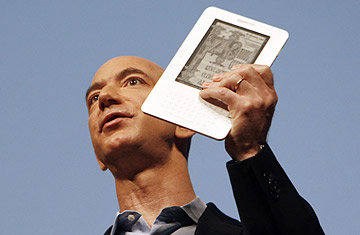
Amazon.com founder and Chief Executive Officer Jeff Bezos holds the new Kindle 2.
Amazon today unveiled Kindle 2, the next iteration of its pioneering e-reader. While fans clamoring for a radical overhaul will doubtless be disappointed — the first-gen Kindle was awkwardly designed and limited by its black-type-on-gray E-Ink display — Amazon has given the device a modest redesign that appears to address some of its more glaring problems. (See the top 10 gadgets of 2008.)
Kindle 2, which goes on sale ($359) at the end of the month exclusively at Amazon, is almost half as thin (.36 inch) and more capacious (holds more than 1,500 books) than its predecessor, with a sleek, Apple-like aluminum back. While its six-inch screen is the same size as the former model and still cannot render color, it will now display16 shades of gray, versus 4 in the original. That should improve the crispness of text, images and photos. Amazon also claims the new Kindle's battery can hold a charge 25% longer than the 1.0 version, allowing it to putter along for two weeks with its wireless connection off. (That connection, to a high-speed cellular network called WhisperNet, allows users to download books and periodicals virtually anywhere, on demand, and was Kindle's crowning achievement.) Page-forward and page-backward nav buttons, which were too easy to accidentally hit on the old model, have been re-thought, too.
The new Kindle also has something billed as an "experimental read-to-me feature" — users will be able to invoke a text-to-speech function, similar to that on most computers, that will turn any text into audio. Audio, that is, read by a synthesized computer voice (male or female, your choice.) While not nearly as natural sounding as, say, Audible books, some users might figure this is better than nothing. (See 25 must-have travel gadgets.)
While Kindle 2 might help book publishers, it continues to frustrate periodical publishers. Aside from different logos, all newspapers and magazines look the same on a Kindle since it cannot render different fonts. And, because it can't yet handle color, it's a bleak format for magazines, which heavily depend on color photographs, illustrations and artful packaging.
Nonetheless, in an interview last month, Martin Nisenholtz, who oversees the far-flung digital operations of the New York Times, said the Kindle has been a "surprisingly successful" platform for his newspaper. "There's not a lot of evidence right now that people view the PC as the device they want to read on," he said. "And that's interesting because the PC is a general-interest device — we had hoped to see a little bit more of an uptake on that. On the other hand, we've seen a tremendous amount of uptake on the Kindle. It just works from a user perspective."
Nisenholtz says the Times is the top-selling periodical on at the Kindle Store, though a non-disclosure agreement with Amazon prevents him from quantifying that statement. "We continue to see an explosion of form factors," he added. "But I don't see anything right now that is bursting through like the iPhone did or the Kindle can potentially do going forward." (The Times' iPhone app has been downloaded more than a million times, he said.) (See the top 10 iPhone applications.)
The race to build a better e-reader is just getting started, of course, and Amazon's success is far from assured. Mountain View, California-based Plastic Logic, whose reading device is still a year away from launch, was set to announce a number of partner agreements today, including USA Today and the Financial Times. Though still in prototype, that e-reader is thinner than Kindle2, features a touchscreen the dimensions of a sheet of paper and can render virtually any typeface.
